As we announced in a preceding issue, we publish today a study on the ever mysterious problem of the Flying Saucers.
We think that the developed theories will interest the readers by their originality but we do not believe - not more than their author besides - that they will convince them all.
Therefore our columns will remain open to the possible contradictors...
As it was said in a preceding issue of "Forces Aériennes Françaises" ["French Air Forces"], to write an article on the "Flying saucers" in a serious magazine is a mark of obstinacy and optimism. But to want to find an explanation to them, whereas their existence is considered by many to be a huge joke, is an even riskier task. I would have liked, before undertaking it, to have the comfort of the absolute certainty. Unfortunately, I will soon be the only one not to have seen "Flying Saucers."
I dealt with these strange crafts under the following conditions: a study of the developments in the human technologies, to which I devoted myself these last years, led me to imagine the "ideal supersonic and interstellar craft." This craft, in the current state of our knowledge, appeared to me as impossible to build and I did not think that we will see it contrcuted before many many years. However, I discovered one day, with the astonishment which one guesses, that it already existed: it was, of course, the Flying Saucer.
It is not possible for me to develop here the theory which had led me to imagine my interstellar craft. I thus ask the reader, if he remains open to the discussion of its principle, being based on the most traditional physics, to consider this theory, taken as a whole, as a postulate and to be interested especially in the applications which are deduced from it.
Do not expect sensational revelations about the Saucers. I certainly would have liked to give its exact blueprint, with graphs representative of their various parts; I am unfortunately not that far. Thus, it is ultimately not a solution, but only the principles of a solution, that I submit to the reader.
Propulsion by a field of forces
The study of the means of human displacements brought me to the following conclusion: "the propulsion by field of forces will mark the term of the improvement in the technique of displacements at very high speed." This field of forces, to allow displacements in all the directions, as well in the atmosphere as outwards, will have to be created from an omnipresent artificial or natural cosmic energy. The system of reference, from the reaction point of view, will be thus some sort of difference of potential of this energy in space, local potential difference caused by the craft itself, by release or absorbtion of this energy in the form of an energy of another nature. This capital function will have as intrinsic result the creation of a field of forces between the extreme points of the zone of release or absorbtion. This necessarily implies a single direction of this function; we will see further how certain deductions seem to indicate that this direction is imposed by a solenoidal magnetic field, in the case which interests us.
The photometric swivel uses a principle of propulsion which presents some resemblance to this system: white and black colourings of the two pallets causes a "difference in potential" of the energy which is, in this case, the luminous energy; the pallets are subjected to a force which involves the rotation of the swivel, without any visible reaction system which may be defined.
If one supposes an ambient energy much more important than that of light, and the fact that the craft has a process to capture this energy similar to the bicoloration of the pallets of the swivel, one can deduce from it that there will be propulsion.
What could be the origin and the nature of this cosmic energy? One can imagine artificial distributors such as some sorts of radio station projecting energy rays in space for the space flights. But it may be more simply, Nature, which may provide this free energy.
A fabulous source of energy
I ask readers to make an assumption as I do. It is that this fabulous cosmic energy exists. One may ask, why has it not yet been detected? Perhaps because it is electrically and magnetically neutral or because we did not yet invent the instruments to measure it. The discovery of the cosmic rays is not so old and we certainly have not exhausted all the surprises that Nature reserves us. I devoted myself to a study, not very precise it is true, of the possibilities of this energy, and I think that one could find a response to many mysteries of modern science with its help, in particular with the gravitation and the most disconcerting corpuscular characteristics (indiscernibility, indetermination, agitation, etc.) The results of this work are very tempting, despite not being indisputable.
Moreover, the existence of the cosmic radiation gives weight to this assumption. These cosmic particles represent condensations of energy reaching the enormous figure of 1016 electrons volts, that is to say approximately 100000 times the energy which a complete "sublimation" of the uraniem core could provide - if it were realizable. Maybe there are still much more powerful energies which cross even the wilson bubble chambers following rectilinear trajectories (when we trace them) without letting their energy analyzed, without allowing their qualitative analysis.
In the atmosphere of the Earth, these particles fall as a sort of rain which is not very dense, at least in its aspects locatable in the experiments: a corpuscle per cm2 and minute on the sea level. But they nevertheless indicate a fabulous basic energy: one would need giant cyclotrons indeed to obtain corpuscles animated by such energies. However, no force which can explain these mysterious condensations of powers was detected in space.
This is why it does not seem incoherent to preferably admit this postulate of a natural cosmic energy instead of an artificial energy.
My craft was at this stage very theoretical and very incomplete, and did not seem to go beyond that stage when I herad for the first time about the Flying Saucers. Like everyone I read the description of these strange and whimsical phenomena with an amused scepticism, until the day when I made a disconcerting observation: certain characteristics of the Flying saucers corresponded to those which "my" craft would have had. Did that mean that it really existed? Was cosmic energy now more than a postulate?
I started a serious study of the worthiest of faith testimonies at once and discovered with an increasingly large astonishment that all the alleged nonsense which the opponents of the Flying Saucers denounced could actually be the completely normal consequence of the propulsion system that I thought they used. I had explained their silence, thermal resistance, changes of aspect, habitability, then all the other anomalies.
These checks were advantageous to me. For each explanation an orientation of my research corresponded, and I could little by little obtain a more exact idea of the nature of these crafts and the mysterious force which animates them. This work of "physicist detective" that I achieved only by force, not having the means of direct experimentation, was ultimately particularly fruitful, since I could foresee certain characteristics, confirmed later on by witnesses, such as the eccentric spot appearing on certain photographs or... the travelling cloud.
The mysteries of the apparitions
One can imagine that the craft uses a process of release of cosmic energy similar to that which, in nature, creates the primary emissions of cosmic radiation starting from this same energy. Just as this "releasing" function generated a speed on the natural cosmic corpuscles - and therefore, an extraordinary energy -, in the same way cosmic energy would radiate in the form of " corpusculo-undulatory " fluid through the craft during this artificial release, in a well defined direction - that of the propulsion - and at a speed about that of the light. This fluid would impose on each receptive atomic nucleus a force directed in the direction of the flow. Thus the field of driving powers of my theory would be created. There would be a kind of continuous cosmic sheaf presenting some analogy with the cosmic sheaves photographed by the scientists, but of different nature, if only by its density and its direction of fall. Moreover, it would not be due to primary elections of great energy, but by a direct capture of the mysterious energy that causes cosmic radiation. Initiated by the craft, it would follow it in its race, would propel it and would sustain it with the stop, a little in the manner of the water jets on which the table tennis balls dance in the shooting ranges of tfun fairs.
One can admit, in addition, without same making this last assumption, that the intensity of the field of forces decreases without discontinuity as one moves away from the craft, because of progressive weakening of the capacity of release of energy and the receptivity communicated to the atoms. One can, consequently, reasonably expect that surfaces, places of equal intensity, spherical or ellipsoidal and would be centered on the craft. Let us name them equidynamic surfaces and let's call tension fields the fluid axes, although nothing proves that the force is constant along these nets, by supposing simply that it is tangent to it at each point. I hope I am excused for this distorsion of these traditional names.
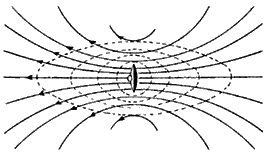
Figure 1
Example of lines of forces and equipotential surfaces
in an axial displacement (very important speed).
The atomic nuclei of the ambient air, just like those of the craft, would undergo the influence of the created field. They would thus tend towards a certain speed, equal to that of the craft to its vicinity, decreasing according to the distance. With the help of the resistance of the atmosphere, it would thus occur an aerodynamic circulation which speed, i.e. the relative wind, decreases in a differential way to become very weak in the vicinity of the wall. This would lead to the creation of a hyper-thickened boundary layer (exactly the reverse of what we try to obtain in traditional aerodynamics) whose utility will be studied further.
The craft would be propelled by slip at low speed in the direction of the vectorial resultant, as figure #2 shows.
One would get ![]() with
with ![]() .
At very high speed,
.
At very high speed, ![]() being weak relative to
being weak relative to
![]() , there would be an axial displacement.
, there would be an axial displacement.
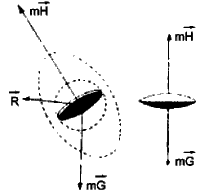
Figure 2
Forces combination
in flat subsonic displacement,
and when hovering.
The main advantage of the system would of course be, because of omnipresence of cosmic energy, that the issue of supply would not exist anymore. As for speed, it would tend, in the almost absolute vacuum of interstellar spaces, towards the speed of the fluid crossing the craft, i.e., probably, nearing the speed of light, if one judges by the speed of the fastest cosmic particles.
In what follows, I will deal only with relatively slow speeds: less than 6000 km/h in average atmosphere and 30000 in high altitude, because the explanations given for the silence and the thermal resistance would perhaps not apply anymore beyond these speeds at the altitudes considered. Moreover, these figures correspond roughly to the maximum figures estimated by witnesses.
The silence
According to all the witnesses, the appearances of the Flying saucers take place in an absolute silence. However, any object which moves in the air is submitted to aerodynamic frictions and leaves a more or less turbulent trough of low pressure behind it. At very high speeds, friction should produce a strident mewing and the trough of low pressure, brutally invaded by the air at discontinuous intervals, would undoubtedly be the seat of slappings and even of thunder claps similar to those heard when a plane crosses the "sound barrier."

Figure 3-4
Figures 3 and 4 give an explanation of this apparent contradiction. Let us consider (fig. 3) a molecule of air located in A, in the most unfavourable case, i.e. in front of the craft and in its axis of motion. The craft moves at a high supersonic speed, 5000 km/h for example. Relative speed is thus of 5000 km/h. But from A to B, it decreases gradually as the molecule meets equidynamic surfaces where the field has an increasingly strong intensity. There will undoubtedly be an adiabatic compression with front and sliding frictions because of the variation of the distance from the axis (at least in this case of diagram), but there would be no supersonic shock with an unspecified obstacle, therefore no noise. In B, which became subsonic and relatively very weak: any risk of noise thus disappeared. After B, the molecule circumvents the mass of air around surface #1 correspondent with a very strong intensity and contacts the wall only occasionally, by turbulence. It is then lost in the airstream which follows the craft and slackens gradually for the same reasons. At no time, the possibility of an unspecified noise appeared.
Thermic resistance
The enormous heat generated by the friction of the air at the very high speeds considered here should as well volitilize any of the 92 pure substances known in our galaxy as well as their alloys. It is not the case, and Flying Saucers cross at a tremedous pace the average layers of the atmosphere without appearing the least inconvenienced.
This abnormal resistance to released heat could be explained by the almost total absence of relative wind in the vicinity of the wall. But there remains all the same the probable heating due to adiabatic compression in front of the craft and turbulence sliding frictions of the layers at different relative speeds. Being unaware of the exact nature of the field, one cannot say a priori which will be the importance of this heating; let us consider the most unfavourable case, the strongly overheated molecule in A. As we have seen above, it can have only occasional contacts with the craft. Indeed, it is necessary that, by turbulence, it succeeds in crossing the zone of strong intensity which causes the formation of the hyper-thickened boundary layer. It can thus have only short contacts with the wall. The heat-storage capacity of the air is low compared to that of this wall and, the capacity of the enormous boundary layer helping, it needs a certain time before sparks of hot air overheat the craft. It is thus possible to fly at speeds normally incompatible with the thermal resistance of known materials during a time proportional to the size of the craft and inversely proportional to its speed for a given altitude. This time will be perhaps very short, but, at speeds of several thousands of kilometers per hour, it is not necessary to fly a long time to cross long distances or to reach the very upper atmosphere in which the question does not arise any more. Moreover, the selected case is the most unfavourable for it is not very probable that the heating is very strong, at least up to five or six thousand kilometer-hour.
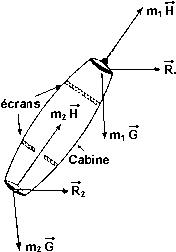
Figure 6 Slow displacement of the "cigar."
This displacement will be necessarily be oblique, then become horizontal at high speed. Observed in particular in Oloron and Gaillac, it was accompanied by the emission of the famous "threads."
Let us note that the cigars were more elongated than shown here for the conveniences of the drawing, and this is undoubtedly to withdraw the central cabin from the harmful radiations. Recall that "flying bananas" were also observed, which would solve the problem without resorting to lengthening, but would prohibit very high speeds in atmosphere.
Inhabitability
It seems difficult, at first thought, to suppose that the saucers are inhabited, for even if one admits as we have just seen it that the aerodynamic heat of friction can be brought back to human standards, because of the mode of propulsion and while limiting to the strict necessity the duration ot the very high speed jumps, it remains that the usually extraordinary accelerations of these crafts would destroy any human organism.
However, the intelligent control of the crafts, their lenghty hovering above certain points which seem to interest them in particular make the remote control very improbable. If thus the craft is inhabited, how can it be explained that the pilot is not crushed at the bottom of the seat by his own inertia, during accelerations exceeding several tens (not to say several hundreds) of Gs?
There again, the principle of the propulsion by field of forces solves the problem. During a strong acceleration in a classical device, crushing is due to the inertia of the molecules which weigh in a very increased way on the seat, origin of this accelerative force. In the Saucer, on the contrary, the force does not come from the seat: it is specific to each molecule. Inertia is fought on the atomic and a fortiori molecular level.
The linear acceleration which results from it is thus the same one for each molecule, and all the molecules progress at the same time, at the same speed, in the direction of the field, without any possibility of an unspecified compressing. Structural and physiological balance remain intact and the pilot can undergo the worst accelerations without embarrassment. Only the atomic ionization caused by very great accelerations puts a limit at these possibilities, but this limit is not an issue, even in an interstellar displacement.
The apparatus and the pilot thus are submitted to an equal intensity of the field. However, the craft, being slowed down by the atmosphere, is actuated at a speed lower than the force applied to the pilot. He still has the risk of being flattened against the front wall. But the problem is easy to solve by a proportioned weakening of the field in the cockpit. It will be enough to regulate this weakening according to the displacement of a masselote mounted near the seat.
As for the turns at right angle, they are very well explained by a swing of the craft to compensate for the centrifugal force by the proportioned action of the field (fig. 9).
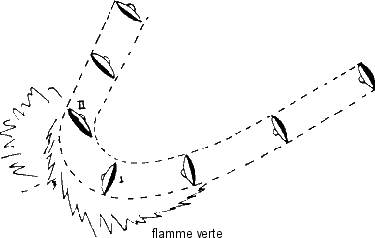
Figure 9 Slow displacement of the "cigar."
Changes of aspect
One of the most unusual characteristics of the Saucers resides in the modifications of their appearance at the liking of an unexplainable imagination. There does not exist, at least at the present time, any known craft transforming itself into a ball of coloured fire.
One could - and it was one of the first assumptions - think of a thermal genesis of the ball. But it is much more probably due to the "corpusculo-undulatory" fluid which makes the air luminescent. It is known that one observes this phenomenon at the exit of certain particle accelerators which are relatively not very powerful. The variation of the colors could be the fact of the variation of intensity or rather the fact of a magnetic field used in the propelling function and which would produce this unexpected Zeeman effect. It is known that the American physicist Noel W. Scott created orange balls in experiments in a rare atmosphere by the sole action of a copper ring under high voltage. He wanted to show the natural electrostatic character of the apparitions. Does he not rather confirm, unwillingly, an electric or electromagnetic aspect of the propulsion of these crafts?
Lastly, as it will be indicated further, the field of forces, by causing a partial vacuum in rise or in oblique descent, can bring the condensation of the steam in the air, supported by possible ionization due to the fluid, and create a flocculent ball, white and whirling, which one indeed finds in description in many testimonys.
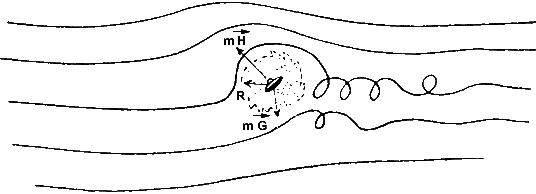
Figure 10
Air flow and reverse
moving ball
in oblique ascent.
In short, the change of aspect can have thermal causes, undulatory, causes, weather causes, or, and it is my opinion, two of the three at the same time.
Here thus an explanation of the mysteries of the Flying saucers. It will undoubtedly have a serious defect for the skeptic reader, that to be based on an obviously undebatable postulate. However, can't it be reasonably admitted that a theory confirmed by so many observations is better as a mockung smile? Isn't the experiment at the base of much of scientific laws?
Therefore I will try to decribe the principal consequences of this strange mode of propulsion. It can easily be realized that the characteristics which result from it have an extraordinary resemblance to the Flying Saucers unusual behavior.
Banking of the craft
The displacement is not made in a constantly identical way. At low speeds, the axis of the craft is appreciably perpendicular within the direction of displacement. It approaches it more and more as speed increases. The craft does certainly not have aerodynamic control surfaces since there is not stable relative wind on which they can act. Thus there must be a gyroscopic stabilization. The change of plate is obtained by offsetting of the resultant at the request of the pilot. One thus has on one hand a probably peripheral revolving part, on the other hand a body to moderate the excentrable field.
And indeed, many witnesses mentioned this banking varying with speed as well as the swing before the tremedous accelerations.
As for cigars, if it is supposed that they consist of a fuselage with two Saucers at the end, it is immediately clear (fig. 5) that they must be tilted on the horizon at low speed, this slope being about that of the axes of possible conveyor Saucers.
Approximate study of speeds.
It seems well that there must be a swirling movement creating a central depression because of the centrifugal forces and divergence of the airflows.
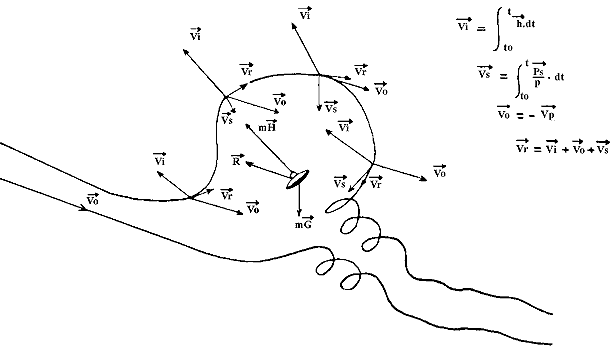
Figure 11 Approximate study of speeds.
I considered the case of the tension fields in figure 1.
Swinging and approach in zigzag
When stopping, voluntary or involuntary, a banking is caused on the corresponding side (see fig. 2). However, it must be difficult, for the pilot, to keep his apparatus flat by his action on the resultant of the field. As direct consequence, in slow vertical descent, the craft falls with a "pendulum" or "falling leaf" movement. In the same manner at the approach of a locality, the pilot leans his craft for better seeing below him and because of that he causes abrupt variations and an arrival in zigzag. Oscillatory swinging, falling leave and abrupt variations were reported many times by witnesses worthy of faith.
Strange manoeuvers
Isolated at full speed in the center of an area limited by extremely hot and disturbed air, the pilot can only have a deformed vision of the ground because of the refraction, heterogeneous through this air. This can explain the abrupt rises, the brutal changes of course, and also the stops of several minutes above the cities and especially the coasts, good reference marks to get a position.
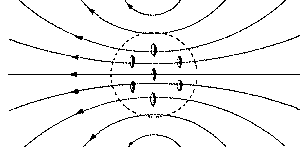
Figure 8
Alignment of lines of forces in a formation flight.
There are equipotential surfaces, and the same conclusions
as in the flight of a signle craft.
Accidents and failures
The craft cannot easily be broken. The pilot causes most perfect brakings by a simple inversion of the field. If need be, a simple standard radar type set can start this braking at the approach of an obstacle. As for the people, they are hardly likely to deliver the remains - and the secret - of the Saucers. Indeed, in the event of a breakdown of the field of forces, at high speed in particular, the hyper-thickened boundary layer disappears in only one blow, and the craft would run up against the motionless air with an extraordinary kinetic energy which would cause its disintegration and its thermal volatilization in a split second, in a thunderous noise.
This is perhaps the explanation of the observations made by two pilots of Aero club of Morocco, in September 1952, outdistanced by a cigar which disappeared in front of them in a shower of sparks, or the mysterious explosion which shook one month later the area of Glancove, near New York.
Creation of ascending air flows
It is possible that one can, in certain cases, attribute the glowing trail which follows the fire balls at high speed to the heating of the air. But, while admitting even that this heating is too weak to give rise to luminous frequencies, it will involve certainly unforeseen ascents and of great width in upper atmosphere. However, jets pilots stated to have met vapour clouds of more than 3000 meters of thickness at more than 10000 meters of altitude. No normal reheating of the air could explain such formations; on the other hand, the extremeemy hot rails left by a group of crafts at very high speed would be enough to cause such ascents.
Cumuli formation
One of the strangest consequences of the propulsion mode was, according to what I had thought, the risk to see a small cumulus being formed in the clearest skies, above the craft stationing at low altitude. Indeed, the airstream subjected to the field "weighing" nothing or almost nothing, a quite sudden ascending draught would occur and possibly burst the disruption of the purity of the sky. And if there were no inversion, the ascent would be only stronger. One would thus be likely to see a small cumulus sudden appearing, seemingly able to move, and maybe against the wind!
Indeed, the newspapers of January 3, 1953 reported the adventure of a plovers hunter, former pilot of the Air Force who saw - with the amazement that you can guess - a small cumulonimbus insulated in a pure sky move vertically, which then spoutted an unspecified thing out of its centre, which disappeared quickly, leaving a white trail behind it. This suggests that the pilot of the craft had voluntarily placed himself in the cloud to benefit from the providential camouflage which it created. I would be happy if this assumption had as consequence to supress the doubts that certain journalists expressed as for the mental equilibrium of the witness - doubt that the witness himself was perhaps not far to feel, during a moment.
Whirling white ball
Around the craft, in the case of an oblique rise, a trough of low pressure due to the centrifugal force created by the whirling is formed, to the divergeance of the airflows and the effect of "suction" of the field. In certain cases of wet atmosphere, and with the help of ionization, a condensation by adiabatic pressure drop will occur in this area and white vapors would follow the aerodynamic circulation. There will be the impression of a white ball climbing the sky while rolling backwards. The case will be identical in oblique descent, and will correspond, like that of the rise, in quite precise conditions of its own speed, of angle of trajectory and humidity of the atmosphere.
The checking of these consequences coming after the explanation given to the four mysteries, and especially the observations of certain characteristics which I had been led to foresee, changed me into a "saucerist." I wanted to find the path to follow to find the solution. But the data of the nuclear and cosmic physics, if it aloows to foresee - in their still irresolute mysteries - the possible fields of investigation, do not make it possible to determine the assembly of the elements ensuring the propulsion.

Genesis of the turn in right angle: from I to II, the pilot brutally rocks his craft to counter the centrifugal acceleration by a proportioned action on the field. A green flame appears which is a mere by-product of the process of capture that the glowing trail masks in straight and level flight. The inertia of the extreme airstream which follows the craft can cause "flames" outside the turn in spite of the action of the field.
Not having the possibility to do some research along these lines, I was satisfied as I mentioned above, to play the physicist detective, basing my assumptions on the observations which appeared the surest to me. I thus give them for what they are worth, and I apologize to my readers for not having taken them along the sometimes tortuous ways that I had to follow. Besides, I will present only the less shocking.
The atoms of the craft must show a characteristic which enables them to undergo the force applied by the cosmic energy in a homogeneous way, as the "bicoloration" of the photometric swivel enables them to undergo that of the light.
This characteristic could be due simply to the action of the solenoïdal magnetic field of an enormous torus, conditioning as one will see it the "receptivity" of the atoms. But the principal element of the propelling function would be the disc itself which would constitute an enormous metal lens. Atomic qualities of its components joined to those of its diopters, would give it a dominating action on a certain part of space, perhaps by the intermediary of the field, and which would lead the cosmic energy to be released in the form of a "corpusculo-undulatory" fluid. This release would be done gradually, in a single direction imposed by the tension fields of the magnetic field, and the corpuscular aspect of the fluid would continue more and more forwards as a dense radiation of positive particles, while its "propelling" energy would decrease by as much.

Figure 11 Aspect that the "Saucer" should have according to my latest assumptions.
The positive radiation would undoubtedly bring negative radiation backwards as by-effect, by wrenching of electrons off the atoms of the air and the craft. The few positive particles already created at the back would be linked with some of them, which would explain the display of these sparks reported by certain witnesses, even in full day. But especially these two radiations would unquestionably cause a luminescence of the air, which would explain the aspect of vague "ball of fire." Moreover, one weak part of these particles would meet when losing their ionization, in the intermediate marginal zone, involving the appearance of plugging glares, which may explain the coloured rings observed by the witnesses. Lastly, the luminescence would probably come with the intensity of the field of forces, "thresholds" surfaces would be appreciably homothetic equidynamic surfaces. The often reported flying eggshape, in particular by two pilots of Air-France, seems to confirm this assumption. Moreover, the evolution of these round surfaces at a stop (swell orange), ovoid with an horizontal axis in full speed (flying egg), seems to well correspond to the evolution of the tension fields of the solenoid, their triple colouring - green, yellow, orange - being then due to a Zeeman effect around the base frequency: the yellow. This would confirm the existence of a magnetic field. There finally, the shapes of "reversed mushrooms" and "reversed ice cream cone" would also find their explanation, by supposing that the electron flow is more luminescent than the positive flow and than it more accurately follows the layout of the tension fields of the solenoid.
An even stranger assumption could explain the masses of "gossamer threads" or "white wadding" which followed many observations, among them those of Oloron and Gaillac on last October. They would represent the trace left behind them by the particles positive combining chemically, perhaps with the course even of their genesis, with the nearby particles or the components to the air, in particular the steam. This implies that the particles would be enormous and the threads extremely tense, from where the aspect of wadding. The brightness of this wadding and especially its exceptional hydrophily, make me think of mysterious salts sublimating themselves in contact with the ground in consequence of the loss of their ionization, causes of their fugitive stability. But as nobody ever cared to collect them, the capital information that would results of their analysis could have given has also volitilized forever, and that is a shame... Let us note that if one thinks of the low density of the primary cosmic radiation which seems made up of positive particles, more precisely of protons, and if one makes gravity correspond, one can easily imagines the enormous "directional gravity" which is able to produce such particles!
As for the piloting itself, the offsetting of the average resultant of the field would be obtained by an excentrable screen which would partly absorb or deviate the accelerating fluid. In addition, the field should be weakened in the cockpit to prevent that the pilot gets plated against the front wall, and also so that the absence of gravity does not come to disturb his physiological balance, which would not even enable him to remain seated. The screen should thus, logically, fulfill these two functions, from where the probability of seeing on the photographs a central "black shade", slightly offset according to the needs, and correspondent with a partial weakening of the radiation, therefore of the luminescence. The photographs taken on last August by Mr Frégnale at lake Chauvet seem to confirm, afterwards, this assumption.
Here are exposed some of the aspects of a theory established without having at the start the least idea than it may apply one day to the Flying Saucers. I said under which conditions I became interested with these objects; on the basis of a postulate: the existence of a mysterious cosmic energy, and an assumption: the possibility of releasing this energy in the form of an energy of another nature involving the application of a force to each atomic nucleus, I tried to define the characteristics of an ideal supersonic craft. I realized thereafter that this craft would have all the characteristics allotted to the Flying saucers.
I know very well that my theory is far from being perfect and that it will satisfy neither the "anti-saucerists" nor the particularly scrupulous scientists. I will priobably be charged to use as basis debatable bases, with a very free construction of the spirit and to seek, in vague testimonys, a confirmation of my assumptions. Without speaking about the precise details brought, at the bottom rather free, on the characteristics of the craft, one will criticize the principle of it even. It is obvious that we currently do not know fields of forces having the tempting characteristic to apply to any atomic nucleus a force whose intensity would be also easily controllable in space and time. Even by admitting this possibility, the laws of traditional mechanics require a system of reference to the reaction point of view, and conentionnal physics does not foresee any of this. Cosmic energy could very well provide it by a type of difference in its potential, but this cosmic energy is itself quite hypothetical. If the genesis of the cosmic radiation can be allotted to it, how to explain that its existence has not been detected yet by other interferences in electromagnetism?
And yet, can the testimonies on the mysterious practices of the Saucers be denied? Reasonably not, in my opinion. Then it should be recongized that only the mode of propulsion consisting in applying a force to all the atoms entirely explains these mysteries, with the only condition that this force decreases, in a continuous way, at the front as well as at the back and that the used process creates a luminescence of the air. If it is added that all the consequences of this mode of propulsion coincide absolutely with the most whimsical observations (and some of these deductions preceded the observations) it should be admitted that hazard did a pretty well job.
Traditional physics rejects the concept of any unorthodox field of forces and even more, rejects that of a cosmic energy which has successfully escaped several centuries of research. But it is perhaps a field which was never approached nor imagined, and where there will be giant leaps of knowledge as soon as it is discovered. Our hypothetical visitors, more advanced than us of a few centuries of of much more time, have a full knowledge of it and this suffices to explain it all.
I know very well that many people will want never to be subjected to these reasons as long as they do not have the irrefutable proof that the Saucers are intelligent controlled crafts. As for myself, and I insist on this point, I am convinced of this. I collected too many testimonies of sane and balanced people to still doubt. Men of science feel reluctant, and they are right, to go fishing for the monster, wether it is the Loch Ness monster or some other monster. This is why it must be proven that the crafts exist and, then at once, they will start to work courageously, bringing to the quest of the solutions as much intellectual audacity than they approached the sunject with great prudence in the first place.
This is why, I ardently wish that a serious investigation, like that which is carried out in America, comes to draw the attention of qualified people on this strange problem. Any explanation, even if it comprises the revelation of a danger to our country or our planet, is preferable to the current inertia. The scoffers, the skeptics and the indifferent ones were never builders or defenders of human achievements.
It is necessary, apart from any joke or of any metaphysical position, to rationally seek the cause of these phenomena. If they are natural, so much for my theories and... my self-esteem. But if it is proven that we really are in the presence of flying crafts, no effort must be saved to determine nature and the origin of it.
Lieutenant PLANTIER.
Note by the publisher. - Our readers are invited to forward their account of observations which they could make of any appearance of odd crafts or unusual atmospheric phenomena to us.